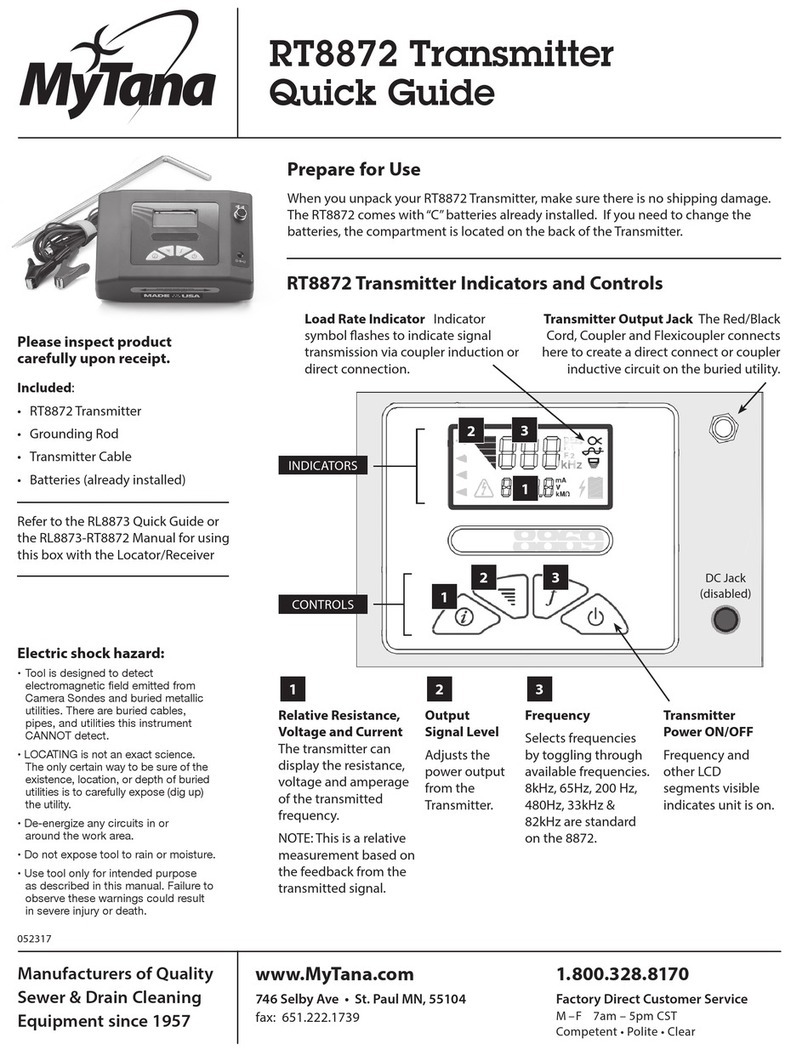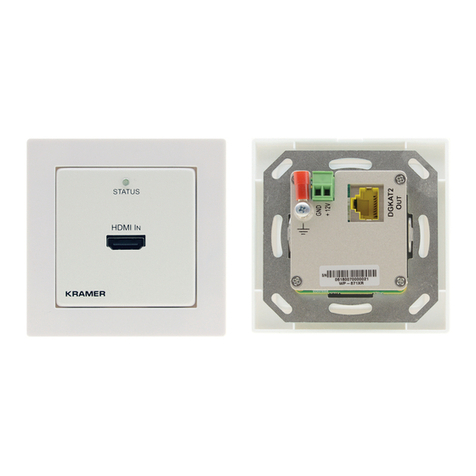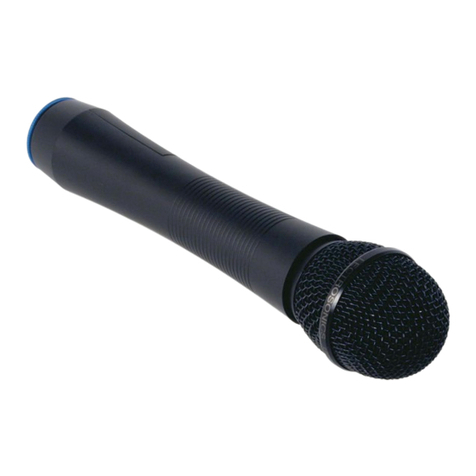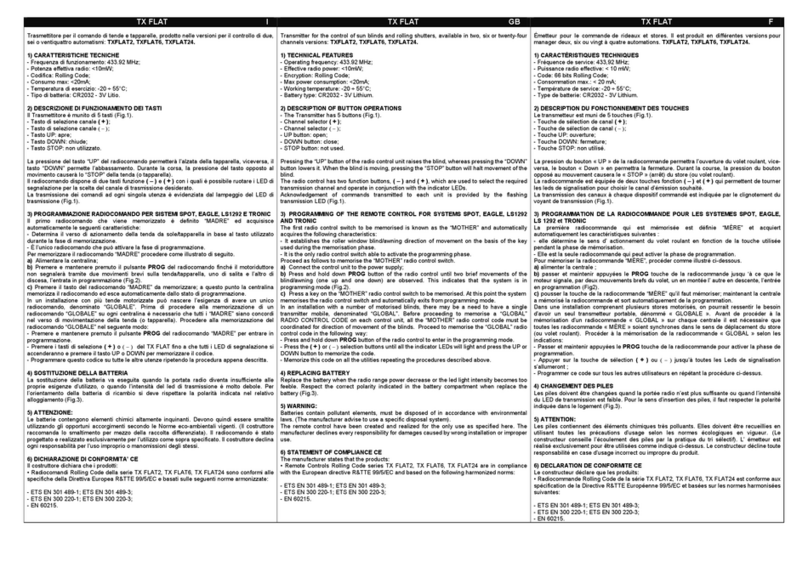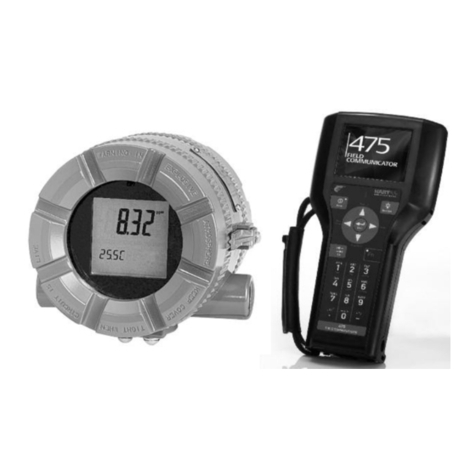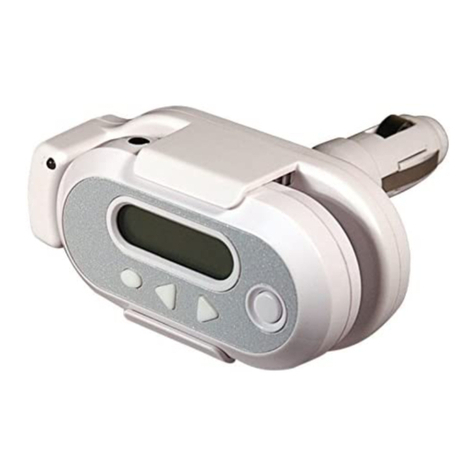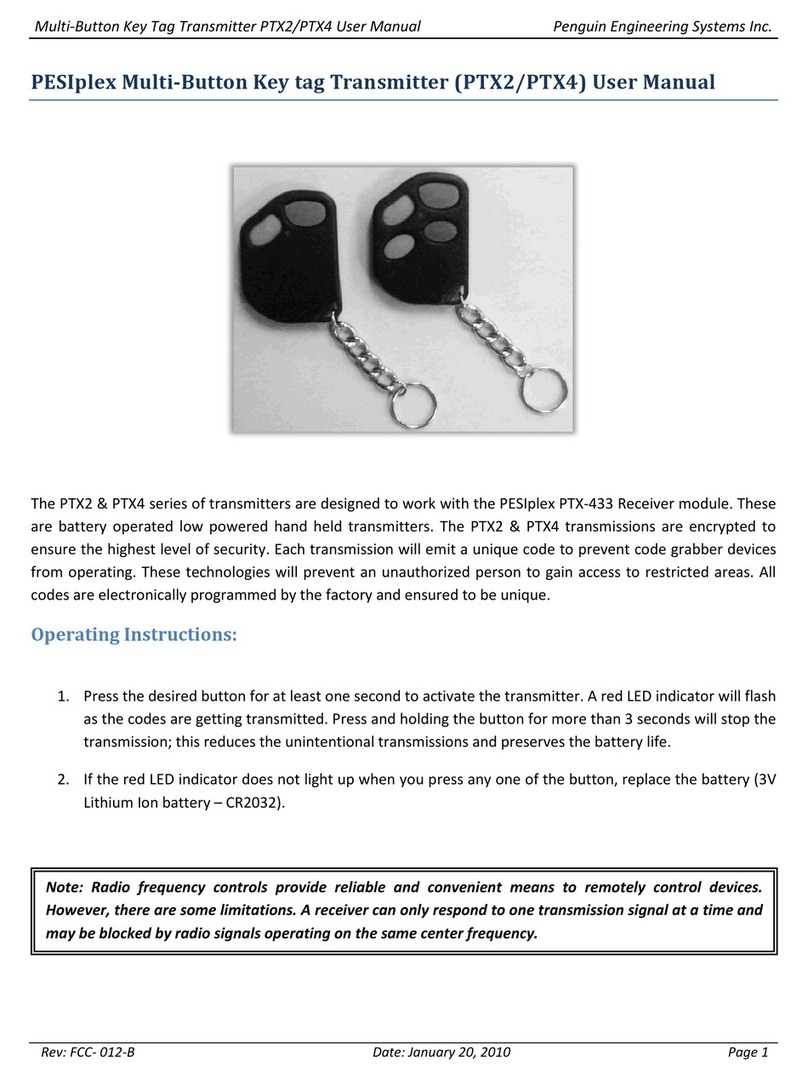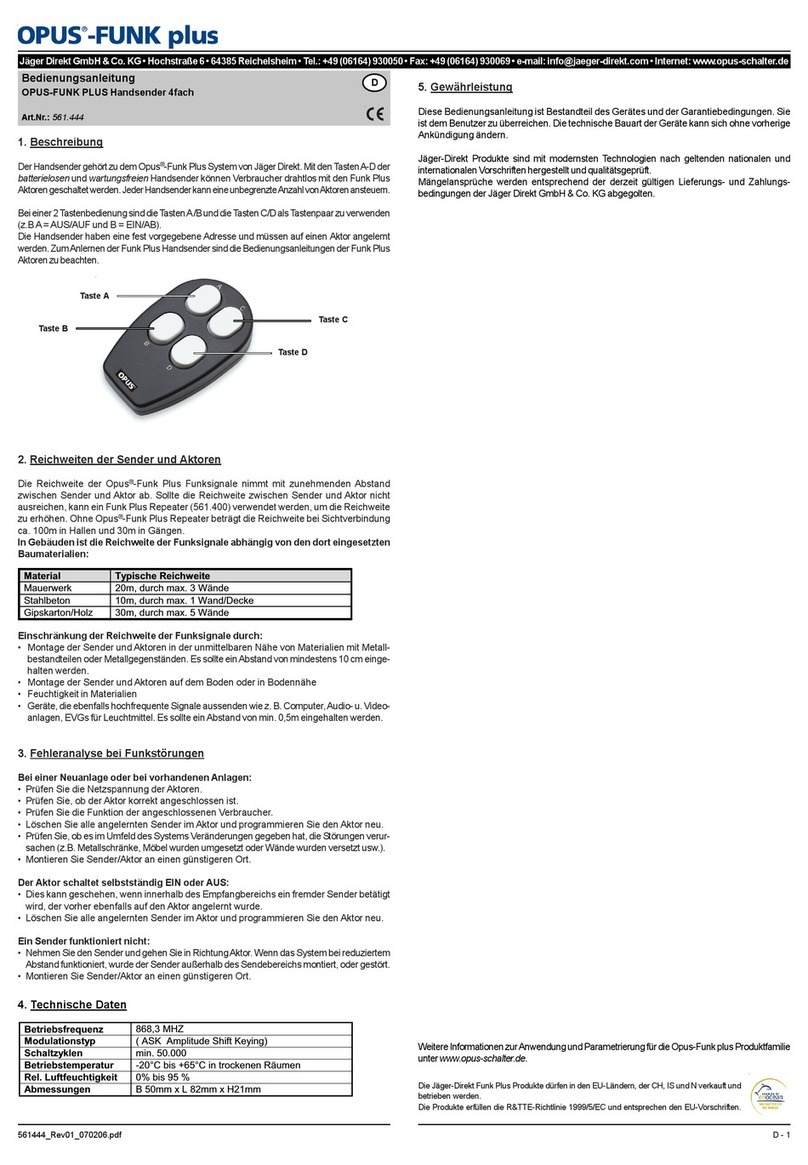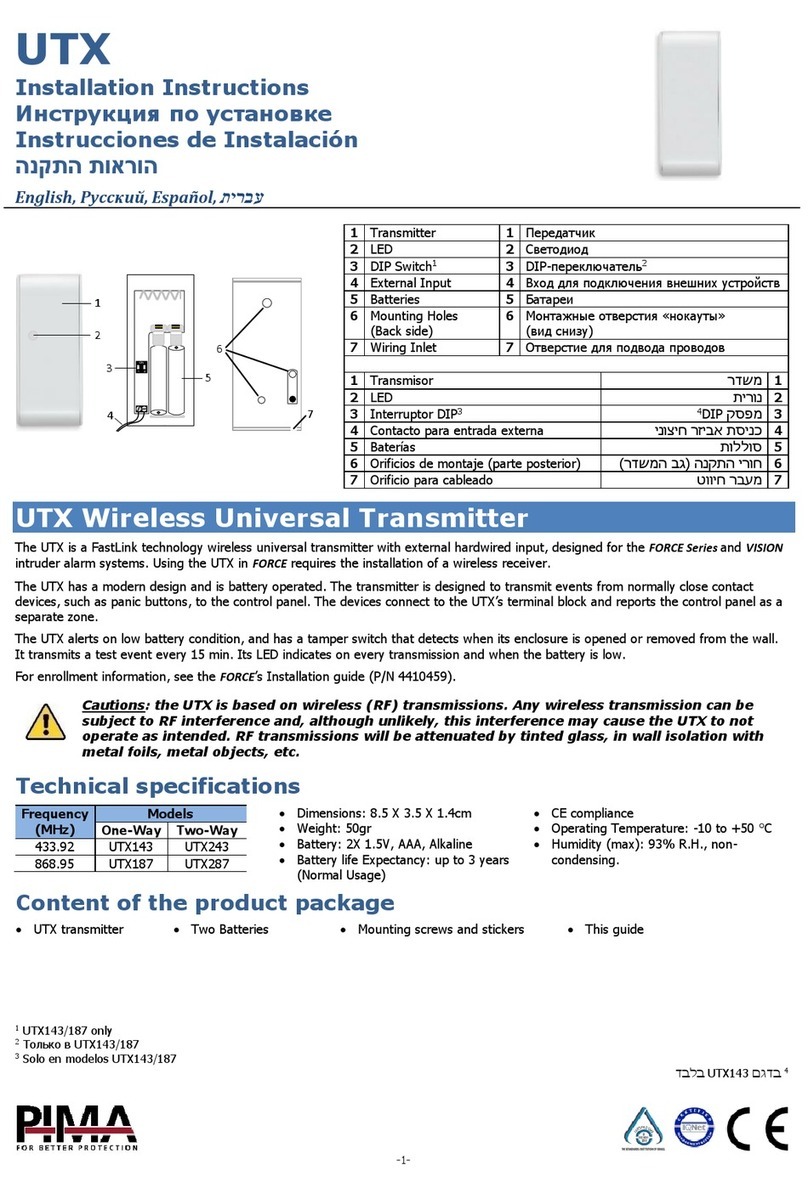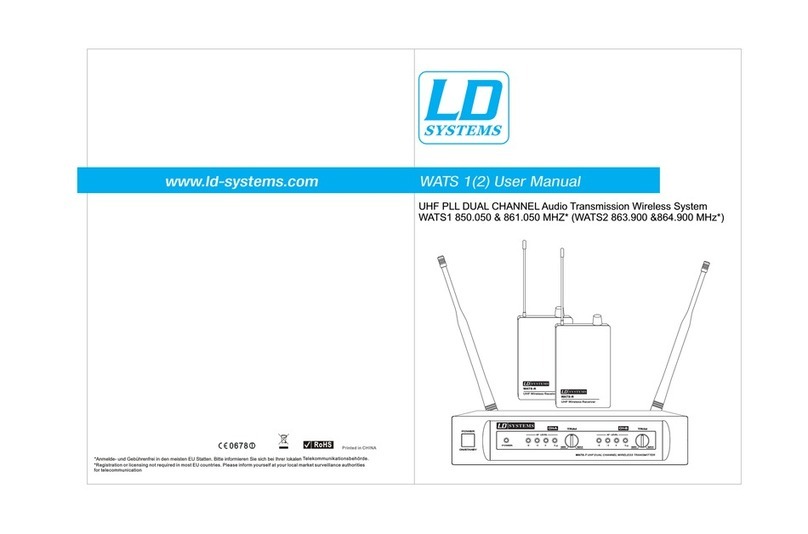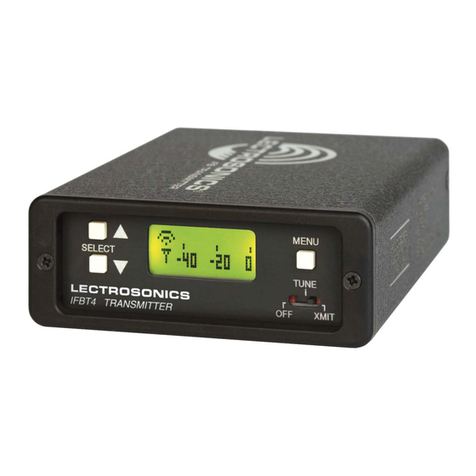MyTana ST LineFinder User manual

Important!!
WARNING! Failure to follow these
warnings could result in serious injury or
death.
• Only persons qualied and trained
to operate cable & pipe locators
may operate this equipment.
• Follow appropriate safety procedure,
your companies policies and applicable
safety codes and/or laws.
• Do not connect to utilities, cables or
pipes without authorization and training.
Use tool only for intended purpose as
described in this manual
• Do not expose tool to rain or moisture.
• Do not expose to hazardous chemicals,
hazardous gas or explosive environment.
• SHOCK HAZARD - Lethal voltages may
be present at the transmitter’s output.
Turn o transmitter before touching
test lead or any un-insulated conductor.
Make connection to ground and target
conductor before turning on transmitter.
• SHOCK HAZARD Do not connect to
live voltage or active utility lines. De-en-
ergize any circuits in or around
the work area.
• This tool is designed to detect electro-
magnetic eld emitted from cables and
buried metallic utilities.
• There are buried cables, pipes, and utili-
ties this instrument CANNOT detect.
• LOCATING is not an exact science.
The only certain way to be sure of the
existence, location, or depth of buried
utilities is to carefully expose (dig up)
the utility.
DISCLAIMER OF LIABILITY
MYTANA LLC SHALL NOT BE LIABLE TO
ANY PERSON FOR ANY INCIDENTAL,
INDIRECT, SPECIAL, EXEMPLARY OR
CONSEQUENTIAL DAMAGES, OR INJURY
OF ANY TYPE WHATSOEVER, CAUSED
DIRECTLY OR INDIRECTLY BY PRODUCTS
SOLD OR SUPPLIED BY MYTANA LLC.
090821
Please inspect all parts
carefully upon receipt.
Make sure there is no shipping
damage and all the parts are
included:
• ST LineFinder Transmitter
• Direct connection cable
• Grounding rod
• Battery recharging cable
(lithium-ion battery
is already installed)
• Carry bag
Introduction
The ST LineFinder Transmitter is capable of
detecting buried power cables, CATV cables,
gas and water pipes, sewer lines, telephone
cables, fiber optic cables with sheath.
The transmitter emits a signal that is
conducted by, or coupled to a conductor (the
buried utiltity). A receiver (such as our ST 512+
Locator) detects the signal. You can locate the
relative position of the buried conductor by
following the tracing signal.
Manufacturers of Quality
Sewer & Drain Cleaning
Equipment since 1957
(800) 328-8170
Factory Direct Customer Service
M –F 7am – 5pm CST
Competent • Polite • Clear
www.MyTana.com
746 Selby Ave • St. Paul, MN 55104
fax: (651) 222-1739
ST LineFinder Transmitter
User Manual

Transmitter Interface
Output Method
Indicator
Frequency Selector
This button toggles
through the available
frequencies which are
displayed on the LCD.
When dual frequency
transmission options
are selected, indicated
by the D1 & D2 icons to
the right large numeric
segments, the frequen-
cies will ash from one
to another.
Battery Condition
Indicator
Power On / O
The ON/OFF turns
the unit on and o.
Output Signal Level
Will adjust the
power output from
the transmitter. There
are 5 selections on the
standard power settings.
Output Jack
The Red/Black Cord,
Coupler and Flexicou-
pler connects here to
create a circuit on the
buried utility.
Frequency Indicator
Relative Resistance
(ohms)
Output Signal Level
see below
Output Signal Level Indicator
(visual & audible)
The Signal Indicator symbol ashes to indicate signal output.
• When the indicator blinks 4 times per second, it is
indicating a nearly short circuit.
• When the indicator blinks 1 time every 10 seconds,
it is indicating a nearly open circuit.
A quick triple beep audible tone indicates the circuit is open
and no signal is being transmitted. A steady continuous beep
indicates a closed circuit and signal is transmitted .
Controls
Operation
To turn unit On / O
Short press on/o button
To engage transmitter from “o” idle
Short press frequency button
– or –
Short press power-output
To change frequencies
Short press frequency button
To change output power
Short press power-output button
Indicators
All controls are also used in
Programming, (see pg 7)
PG 2 MyTana ST LINEFINDER TRANSMITTER User Manual

Coupler and Flexicoupler Connection
• Uses an optional, easy to use Flexicoupler or hard coupler
• Services do not have to be interrupted.
• Shorter operation range than Direct Connection method
• Tracing signal can be aected by nearby cables or pipes
• Requires an insulated conductor that is grounded on
both near and far ends
Couplers need to be attached to the cable needing to be
traced:
• Loop the Flexicoupler around the cable and connect the
two ends or clamp the Hard Coupler around the cable
• For strongest signal, connect around the wire closer
to the outgoing cable not near the system ground.
Connecting near the grounding will shorten the range,
and diculty may arise determining one cable from
another.
Plug the Coupler into the output jack. Some couplers are
frequency specic, others can operate on medium and
high frequencies.
Direct Connection
DO NOT CONNECT TO LIVE OR ENERGIZED POWER CABLES
• The most reliable method of signal application.
• This method is relatively free of interference.
• Achieves the greatest amount of signal strength
• Low, mid, and high frequency may be used.
• The far end of the utility must be grounded.
Connect the Red Cord to an existing ground point or an
exposed metallic section of the utility.
Place the Ground Rod approximately 10' from this point,
at an angle of 90º to the buried cable or pipe. Push the rod
8"-10" into the ground. Connect the Black Cord to the Ground
Rod.
Plug the Red/Black Cord into the Output Jack. Select the
desired frequency. The Signal Output Indicator will ash
once signal is established.
Transmitter Connection Methods
The method of signal application may dictate the frequencies used. While direct connection can be performed on any frequencies,
coupler induction will only work with medium and high frequencies and transmitter induction will only work on the highest of the
medium frequencies (33kHz) and high frequencies.
CAUTION Always turn transmitter OFF before connecting and disconnecting test leads
!
Far end of buried
utility must be bonded
Buried Utility to locate
Red cord connects to utility
(unbound this end for
best results)
Black cord
connects
to the
ground
rod
Inductive coupler
wraps utility
Buried Utility to locate
BOTH Near end and far end
of buried utility must be bonded
PG 3 MyTana ST LINEFINDER TRANSMITTER User Manual

MyTana’s ST 512+ Locator
Locating Modes
There are 2 main operational modes
Sonde
See more about sonde locating in our ST 512+ Locator manual
• Highest signal strength directly over sonde with
gradual decline side to side and front to back.
Receiver must be oriented parallel with sonde.
• Passive Line locating available
• Sonde mode has 2 antenna modes available:
• L/R guidance On
• L/R Guidance O
Line
• for use with the multi-frequency Transmitter
• Multiple antenna modes available
• Line mode has 7 antenna modes available:
• Peak Highest signal strength directly over
conductor with gradual decline side to side.
Receiver must be oriented perpendicular to
conductor.
• Pinpoint Peak Highest signal strength directly
over conductor with sharp decline side to side.
Receiver must be oriented perpendicular to
conductor.
• Null Lowest signal strength directly over
conductor with sharp increase side to side.
Receiver orientation not required.
• Auto Left/Right Guidance Broken tone to left
side of conductor with solid tone to right side of
conductor. Receiver must be oriented perpen-
dicular to conductor.
Selecting the Frequency
Frequencies are classied into three major categories, each with
advantages and disadvantages:
• Low Frequencies < 1 kHz (1000 Hz)
• Medium Frequencies 1 kHz to 44 kHz
• High Frequencies 44 kHz to 480 kHz
The connection method may dictate the frequencies used:
• Direct connection can be performed on any frequency
• coupler induction works only with medium and high
frequencies
• transmitter induction works only with the highest medium
(33kHz) and high frequencies
It is generally accepted that lower frequencies provide a more
accurate locate and are less likely to bleed onto adjacent
non-target lines, but they are less eective on higher-resistant
conductors. Begin by using a low frequency, and continue as
long as you are condent in the results. If the signal is very
weak try to adjust the connection or grounding. If there is no
improvement in signal then try mid-range frequencies. Again,
if there is weak or absent signal, repeat adjustments of the
grounding and connection point before switching to a high
frequency.
Low Frequencies are usually preferred to the mid-range and
high frequencies because they are less susceptible to locating
errors caused by coupling of signal to adjacent conductors,
cables or pipes. The low frequency locating range is also much
longer than the medium and high frequencies. Low frequencies
will not travel well on highly resistive lines or conductors that
have interruptions in their continuity (e.g. disconnected shield
bonds or insulated pipe bushing).
• Low frequencies may only be applied via direct connection.
Medium Frequencies take the best of both high and low
frequencies. They are not as susceptible to bleed o or coupling
as the high frequencies, and medium frequencies can jump
minor breaks in continuity and conduct on higher resistant lines
better than low frequencies. It is still best to use low frequen-
cies whenever eective, but 8 kHz and 33kHz are of the most
common frequencies used in locating.
• Medium frequencies may be applied via direct connection
and via coupler induction [Note: 33kHz may be applied via
transmitter induction].
High frequencies are sometimes better than the low frequen-
cies for locating highly resistant lines as well as conductors that
have breaks in their continuity (e.g. disconnected shield bonds
or insulated pipe bushing). The locating range is quite short for
the high frequencies so the Transmitter must be repositioned
more often during the tracing operation.
• High frequencies may be applied via direct connection,
coupler induction and transmitter induction.
PG 4 MyTana ST LINEFINDER TRANSMITTER User Manual

Peak Mode Locating
• Peak and Pin Point Peak modes have less error rates than
the null locating mode in most circumstances.
• The peak mode location indication should be veried by
the null to ensure locating accuracy.
With the Locator in a vertical position. Move left to right across
the path. When the Locator is directly above the cable or pipe,
rotate the Locator for a maximum signal.
As you move the Locator away
from the cable path, the meter
reading (and audio frequency
response) will drop o.
The Left/Right arrows operate
o of the Null reading. By
utilizing the Left/Right arrows
while in Peak mode the user can
simultaneously locate in both
modes thus quickly identi-
fying the match or discrepancy
between the Peak and the Null
reading.
If you rotate the receiver while
over the cable, a sharp NULL will
identify the cable’s direction which
is aligned with the at side of the
receiver.
Trace the path by walking away
from the Transmitter at a moderate
pace. Move the Receiver to the left
and right while walking, following
the Peak indications.
As you trace the path, the Peak meter reading may slowly fade
as you move away from the Transmitter. Press and release the
Gain buttons as needed to compensate for changes in level
(higher or lower). One of the following may occur:
• a junction where the signal divides and goes several
directions.
• a break in the cable or shield.
• a change in the depth of the cable or pipe.
• an insulated pipe tting.
• a slack loop of cable.
If you can no longer trace the path, even with the Gain set to
maximum, connect the Transmitter to the far end of the path
and trace back to the point where you lost the signal.
Mark the straight sections of the path every few feet. Mark
sharp curves, loops, and cable bundles every few inches. Sharp
changes in the path cause the Receiver Peak and Null indica-
tions to behave dierently than when tracing a straight path.
Practice on the path that you know has turns and laterals in it.
This will help you to recognize the conditions within the eld.
Null Mode Locating
Move the Locator left to right across the cable path. When
the Receiver is directly above the cable or pipe, a Null (lowest
meter reading and lowest audio tone) will occur. When moving
the Receiver to left or right of the Null point, the meter reading
will rise to a maximum point (Peak). The audio tone will also be
at its highest pitch. When the Receiver is moved beyond the
Peak, the meter reading will begin to fade.
Trace the path by walking away from the Transmitter at a
moderate pace. Move the Locator to the left and right when
walking, following the Null indications.
It is expected that in areas of
distortion and interference the
Null locating mode will have
a greater error rate than the
Peak locating mode.
Left Right Auto Gain Directional Locating
The Left/Right arrows operate o of the Null reading and will have the same
error rate as the Null locating mode. By utilizing the Left/Right arrows with
the absolute signal strength reading the user can simultaneously locate with
both Peak and Null modes, thus quickly identifying the match or discrepancy
between the Peak and the Null reading.
In this mode the unit will display directional arrows to the conductor. The audio
indicator will provide a solid tone on one side of the conductor and a pulsed
tone on the opposite side of the conductor. When the unit is centered in the
electromagnetic eld the tone will null and the depth will briey display at the
top of the LCD. This mode is gain independent.
Null shows
line direction
Buried utility
end views
Buried utility
end view
Buried utility
end view
Maximum
receiver signal
Signal over cable
PG 5 MyTana ST LINEFINDER TRANSMITTER User Manual

Current Measurement
Only works on jacketed and grounded cables.
The ST 512+ Locator contains a feature that is very useful in
identifying a desired cable in a eld of various conductors
and/or utilities. It is not unusual for the target conductor (the
conductor connected to the transmitter) to induce a signal
into nearby conductors in a crowded eld.
In these instances, the radiated signal on the conductors
close to the surface of the earth, may be stronger than the
Transmitter signal on the target conductor buried deep in the
ground. The operator will nd two or more paths and must
determine which is the target conductor.
By using the current measurement feature of the ST 512+
Locator, the operator can determine the amount of 815 Hz,
8 kHz, 33kHz or 82 kHz current owing on the conductors,
regardless of the depth. The highest current ow indicates the
target conductor.
Depth Measurement
The only way to be sure of the depth of a utility is to
exposes the utility. At any given time, the depth readout
may be inaccurate.
Depth is determined by reading
the electromagnetic eld radiating
from the conductor. The eld must
be even and circular for the most
accurate reading.
Interference of this eld may be
caused by bends in the cable,
faults on the target conductor and
signals radiating from adjacent
non-target conductors. Interfer-
ence will warp the eld and skew
the depth reading.
The following are methods
and procedures that will aid in
increasing the reliability and
testing the accuracy of the depth
reading:
• Take depth readings at least 5 yards from cable bends or
depth changes. Follow the cable both forward 5 yards
and backward 5 yards, ensuring the line is straight and
there is a consistent signal strength reading.
• Check for non-target conductors within 5 yards of the
target cable. Sweep the area looking for coupled signals
into both the tracks and adjacent cables. Adjacent
conductors carrying the locate signal can result in a 50%
error rate of the depth reading.
• Test for interference in the magnetic eld by comparing
the PEAK location to the Null location. The determined
cable position by these methods should be within 3
inches of each other. A greater disparity will indicate
interference resulting in inaccurate depth.
• Place the receiver vertically over the conductor and
perpendicular to the conductor. Rest the foot of the
locator on the ground. Take several depth readings
moving slightly across the perpendicular plane to the
conductor looking for the lowest depth reading.
• Once the lowest depth reading is found, take several
readings. Each reading should be within one inch of the
other reading. Wider variation will indicate interference
resulting in inaccurate depth.
• Lift the receiver up 12 inches
and take a depth reading. The
reading should reect the
change in distance accordingly.
If not, interference is present
resulting in inaccurate depth.
Peak & Null readings match
From the Peak/Null
location take several
readings across cable.
Mark position indicated by
lowest depth reading.
While stationary take
multiple depth readings.
Reading should be
consistent
Lift 12"
PG 6 MyTana ST LINEFINDER TRANSMITTER User Manual

Changing preset functions,
modes and frequency sets
The ST LineFinder’s programming menu lets you preset the
frequencies you use most often so they will be available every
time you power up the transmitter.
To program the desired frequency set for software versions
3.43 and greater:
Press and hold depressed the Power On Button.
Short press the Frequency button to toggle
through available congurations until ‘U5’ is
displayed in the LCD
Release the Power On button — ‘PRO’ will be
displayed on the LCD
Short press the Frequency button to toggle through the
available frequencies.
To select and store a desired frequency
press and hold the Frequency button for 2 seconds.
The preset count of the selected frequency will be
displayed on the LCD
Continue to toggle through and select the desired
frequencies
Press the Power On button to shut the unit o.
This will save the selected frequencies for availability
during normal operation.
Factory Service
If your equipment is not working properly, call MyTana
Support at 651-222-1738 for assistance. If the transmitter is
in need of repair, MyTana will provide instructions for
returning it for service.
• Note: There is a minimum charge for repair and handling.
Specications
Operating
Frequency
Passive 50Hz & 60Hz, Passive Rf, 512Hz,
640Hz, 8Khz, 9Khz, 33Khz, 65Khz,
82Khz, 200Khz, 478Khz
Operating
Temperature
-4°F to 133º (-20ºC to +55ºC)
Hook-up Method Direct Connection, Inductive Coupling
(with optional coupler), Transmitter
Induction
Load Matching automatic from 5 Ω to 30,000 Ω
Battery Type 8: C alkaline batteries
Battery Life Greater than 30 hours*
*depending on load, frequency and
power setting
Dimensions 8.4" x 5.57" x 2.6"
Weight 2.2 lbs (0.99kg)
PG 7 MyTana ST LINEFINDER TRANSMITTER User Manual

(800) 328-8170
Factory Direct Customer Service
M –F 7am – 5pm CST
Competent • Polite • Clear
www.MyTana.com
746 Selby Ave • St. Paul, MN 55104
fax: (651) 222-1739
PG 8 MyTana ST LINEFINDER TRANSMITTER User Manual
Table of contents
Other MyTana Transmitter manuals
Popular Transmitter manuals by other brands

Extron electronics
Extron electronics FOX3 T 201 user guide

Greystone Energy Systems
Greystone Energy Systems NDD Series installation manual
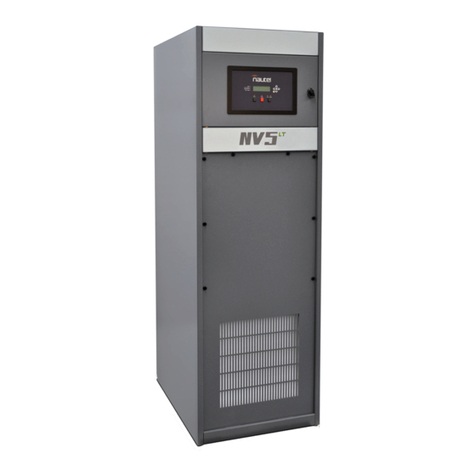
Nautel
Nautel NV5LT troubleshooting manual

Inovonics
Inovonics EN1210EOL EchoStream installation instructions
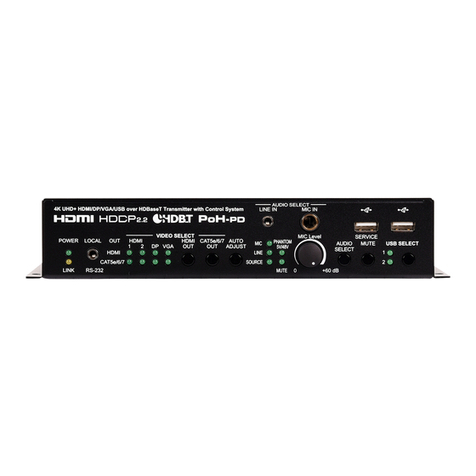
CYP
CYP CH-2603TX Operation manual

Toa
Toa WM-5325 operating instructions
